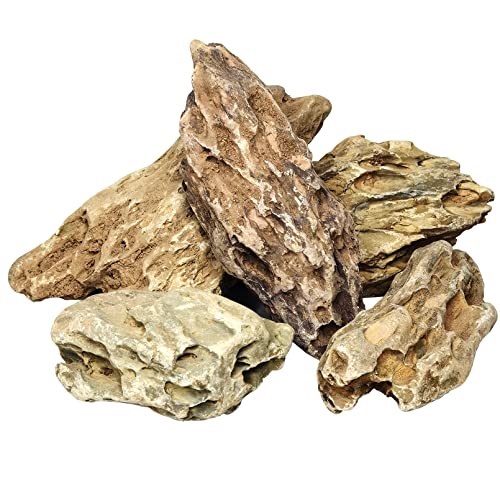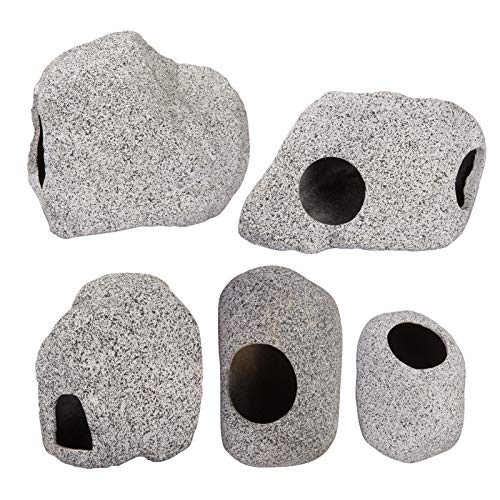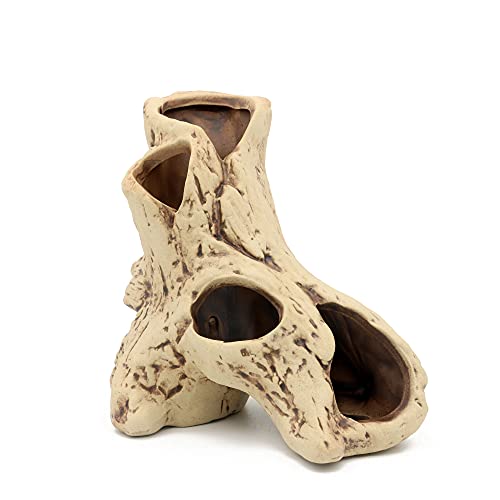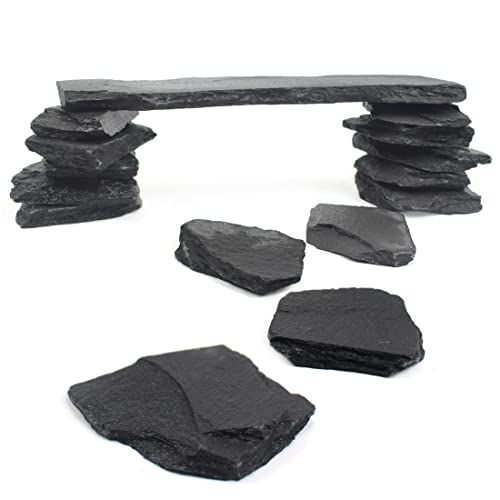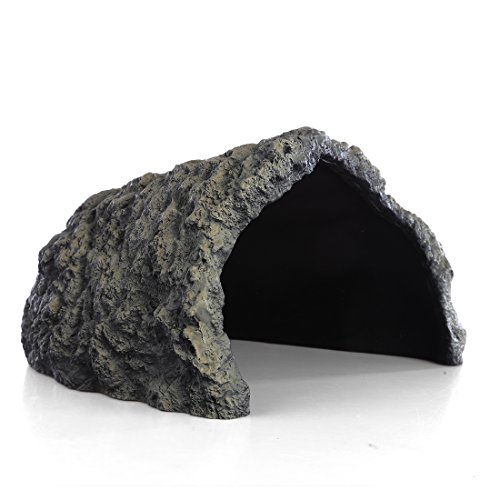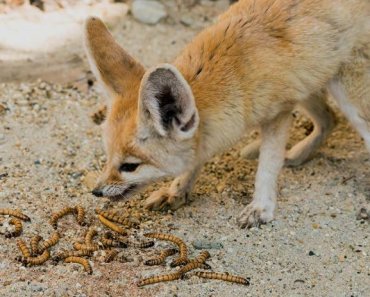Cichlids make fascinating pets. These tropical fish are relatively easy to keep, provided you set their tank up correctly and feed the fish a balanced, high-quality diet.
One item of decoration you definitely need if you want to set up a cichlid tank is a cave. Many cichlid species are territorial, and the fish can become aggressive toward their tank mates if they don’t have a hideout to take refuge in and defend.
Read this guide for reviews of five of the best cichlid caves on the market.
Natural Ohko Dragon Stone Rock
- 4.5lbs of Aquarium Ohko Dragon Stone Rock, 100% natural stone, Mixed Size. Each parcel is unique as no two stones will be alike.
- Excellent for aquascaping, Igwami aquariums, terrariums, vivariums, reptile tanks, amphibian tanks, and other pet enclosures.
- These stones can be used individually or in combination. They can be combination together and used to create caves, cliffs and mountain ranges for pets, fish and plants.
We earn a commission if you make a purchase, at no additional cost to you.
Fish keepers can use these rocks to create natural stone caves or make a random pile of rubble that resembles the natural cichlid lake habitat.
You can buy these rocks in various sizes suitable for dwarf cichlids and smaller African cichlid species, such as Mbuna and German blue rams. These aquarium-safe rocks won’t affect your water chemistry.
What we like:
- Don’t affect water quality
- Beautiful, natural-looking rocks
- Customizable cave material
Room for improvement:
- Variable sizes and quality
Stackable Aquarium Decoration Rock Caves
- Smooth Edges: The surfaces and interior of our 5 pieces of stackable aquarium decoration rock caves are all smooth and have no rough edges.
- Stackable Design: With flat bottom and light weight design, our ceramic hideaway hollow stone can be stacked on the ground in your fish tank to create a unique scene.
- Ceramic Material: Made of high-quality ceramic material, the stackable aquarium decoration rock caves will help purify the water.
We earn a commission if you make a purchase, at no additional cost to you.
These ceramic rock caves come in a variety pack of five pieces. The caves are of slightly different sizes and are stackable, enabling you to create an interesting aquascape to complement your tank.
The caves are smooth with no rough or sharp edges that could harm your fish. All you need to do before adding the decorations to your tank is rinse them in clean water to remove dust.
What we like:
- Don’t affect water quality
- Natural-looking caves
- Five different sizes
- Stackable for imaginative aquascaping
Room for improvement:
- Only suitable for very small cichlids
ALEGI Aquarium Tree Stump
- The product is ceramic material, not easy to fade, no harm to fish, climbing pet, no pollution, you can rest assured to use.
- Imitate the shape of the tree trunk, improve the appearance of the aquatic environment of the aquarium, add a natural atmosphere.
- Multiple hole design, easy to observe, for pet fighting fish or other small fish to hide, rest, play, breeding.
We earn a commission if you make a purchase, at no additional cost to you.
This gorgeous ceramic tree stump can make an attractive cichlid cave for smaller species.
The tree stump has multiple entrance holes, making incorporating the decoration into your hardscape and planted design easy. The material doesn’t fade and is easy to clean
What we like:
- Doesn’t affect water quality
- Natural-looking tree stump design
- Multiple entrance holes
Room for improvement:
- Only suitable for small cichlid species
Blue Handcart Natural Slate
- 100% real natural slate stone will add beauty and realism to your creations, Natural grey slate that are darker when wet.
- 3 Pounds Slate Stone – Consists of 1piece slate about 8 inches long and other smaller slates 2 to 3 inches, Larger pieces can also be broken to suit your needs.
- These PH neutral stones will not affect water in your aquarium and are excellent for aquascaping, aquariums, terrariums, vivariums and other pet enclosures.
We earn a commission if you make a purchase, at no additional cost to you.
If you keep larger cichlid species, you’ll love these 100% natural stone pieces you can use to create caves and rockpiles in your aquarium.
The slate weighs around three pounds and comes in random-sized pieces that you can break to suit your requirements. The stones are pH neutral, so they won’t affect your water quality. For safety, we recommend using aquascaping glue to fix caves securely, as large fish could dislodge the rocks.
What we like:
- Can be used to build large caves for big fish species
- Safe for aquarium use
- Enables custom design creation
Room for improvement:
- You need to fix your design with aquarium glue for safety
Lingxuinfo
This large resin cave is ideal for use in tanks with large cichlids, such as Flowerhorns.
The cave is designed to resemble a sunken piece of bark and blends beautifully with plantings and other decorations to create a realistic-looking feature in your tank. The cave is easy to clean and safe for use in fish tanks.
What we like:
- Can be used for larger cichlid species
- Safe for aquarium use
- Realistic appearance
Room for improvement:
- Variable quality and a few users reported some rough surfaces
Do Cichlids Need Rocks?
So, a display of aquarium rocks and caves looks great in your fish tank. But do your cichlids really need rocks in their environment?
Territory
Most cichlid species kept in home fish tanks are very territorial. Now, that doesn’t mean you can’t create a community, but you must provide the fish with rocks and caves to accommodate their natural behaviors.
Cichlids use rocks to mark out the boundaries of their territory. So, if you provide the fish with caves and rocky outcrops, they will claim specific parts of the tank. That keeps stress and aggression to a minimum, as it stops individual fish from trying to defend the entire tank.
Often, cichlids choose caves formed by rocks as their territory. For example, Mbuna African cichlids often pick a cave and defend it against other fish attempting to move in.
Shy Fish
Some fish species are quite shy and like to hide away, especially when larger fish spawn and aggression levels in the tank increase.
Caves and rocky overhangs make the perfect hideouts for these timid fish. Having somewhere to hide prevents fish from being injured if a scrap breaks out and helps keep stress levels to a minimum, preventing disease outbreaks.
Breeding Behavior
Many cichlid species, such as Kribensis, use caves when spawning.
The male Kribensis stands guard outside the cave entrance while his mate tends to the eggs inside. Once the eggs hatch, the male and female fish escort their tiny babies around the tank, defending them against other fish that get too close. The mom and her brood return to the cave between excursions.
How To Choose The Best Cichlid Rocks
So, now that you know cichlids need rocks, how do you choose suitable caves and stones?
You can choose either natural or artificial rocks for your cichlid tank; either is fine. However, there are a few things to be aware of when selecting rocks and caves for your tank.
Safety First!
Fish are very prone to injury from unsuitable tank decorations, especially species with trailing finnage.
So, you need to check EVERY DECORATION you add to your fish tank for sharp edges or rough surfaces that could injure your fish. The last thing you want to do is to have your cichlids rubbing against an abrasive surface whenever they enter a cave.
Now, you can smooth out any sharp edges using a metal file or a rasp, provided you go slowly and carefully. However, it’s much easier to simply choose something that’s already silky smooth.
Top tip: To test rock surfaces and cave entrances, place a piece of pantyhose over your hand or fingers and run the nylon over the rock. If the pantyhose gets snagged, that rough edge could harm your fish and needs smoothing before adding it to your tank.
Different Sizes
You must ensure that the caves you choose or build are the correct size for your fish. For example, a tiny fish won’t feel safe and secure in a huge rock cave.
Conversely, a big fish will get stressed if it can’t comfortably fit inside a cave. Large species can easily dislodge lightweight ornaments, so bear that in mind and pick larger rocks.
Using Natural Rocks
You might think you can save some cash by picking real rocks from your backyard or local park. To some extent, that’s true; you can! However, you need to be sure that the stones you choose are safe and suitable for your aquarium.
How so?
Well, depending on where you live, the rocks you find in your backyard could easily have absorbed harmful chemicals, including fertilizers and pesticides.
Those chemicals could leach out of the rock into your aquarium water, poisoning your entire collection of livestock. Rocks found in local waterways or at the beach could have been tainted by agricultural and industrial pollutants.
What Type Of Rock Is That?!
Also, you need to be sure just what kind of rocks you’ve picked up.
Some rocks contain minerals that will gradually find their way into your fish tank water, potentially changing the pH and water hardness.
Many cichlid species need very specific water conditions found in their natural habitat. If the water parameters are unsuitable, your fish will become stressed and won’t thrive.
So, if you’re going to use natural rocks that you’ve foraged from anywhere other than on the shelves in your local pet store, you must test your aquarium water every day to ensure the parameters haven’t changed.
Calcium Carbonate
One common mineral contained in rocks is calcium carbonate (CaCO3).
The big problem with calcium carbonate is that it can gradually leach carbonate and calcium into the water over time. So, why is that a problem for your fish?
- Calcium increases the general water hardness (GH).
- Carbonate raises the carbonate hardness (KH) of the water.
- An increase in KH also increases the water pH.
Carbonate rocks are not ideal for fish that love soft water, such as South and Central American cichlid species. These fish do not appreciate the additional GH and higher pH that the presence of calcium carbonate causes.
However, if you want to increase the GH of soft water for African cichlids, adding rocks rich in calcium carbonate might be useful.
Testing Rocks For Calcium Carbonate
You can test rocks for the presence of calcium carbonate before adding them to your tank, which can save you a lot of hassle and lost fish. To do that, all you need is an aquarium nitrate test kit.
Nitrate test kits contain two test solutions. The first contains sulfuric acid, which interacts and fizzes if it comes into contact with any calcium carbonate present in the rock.
All you need to do to test your rocks for calcium carbonate is carry out the following simple procedure:
- Add a few drops of the nitrate test solution to a small area of the stone.
- Observe the rock for a few minutes for signs of fizzing or bubbling, indicating the presence of calcium carbonate.
- Rinse off the testing area thoroughly with some clean water.
Once you’re sure the rock’s composition won’t adversely affect the water in your tank, clean the rocks thoroughly, as described below.
Bacteria
Another potential big issue with using rocks taken from the natural environment is that they could be contaminated with bacteria and parasites.
So, before you add rocks to your fish tank, you’ll need to clean them thoroughly.
To clean the rocks, you’ll need:
- A scrubbing brush
- Bucket
- Tap water
- Plain bleach with no added cleansing agents or scents
- Dechlorinator
How To Do It
- Start by scrubbing off any visible dirt with your scrubbing brush and clean water. Don’t use any soap or household cleaning agents!
- Use a bleach mix of ten parts water to one part bleach in your bucket.
- Soak the rocks in the bleach solution for at least half an hour. That should be long enough to kill any bacteria or parasites hiding on the surface or inside cracks in the rocks.
- Empty the bleach solution, and rinse the rocks until you can no longer smell chlorine.
- Now, put the rocks back into the bucket. Add water to cover the stones and add five times the usual dose of dechlorinator for the volume of water used.
- Soak the rocks for another half-hour.
- Remove the rocks from the water and allow them to air dry.
Now, you can add the rocks to your fish tank, safe in the knowledge that any nasties have been eliminated!
Final Thoughts
I hope you enjoyed our guide to the best cichlid caves and the top tips and information we provided on choosing suitable caves and rocks. Please remember to share the article if you found it helpful!
Cichlids need rocks and caves to establish territories for breeding and as shelter in times of stress. Ensure that any decorations you add to your fish tank are free from sharp edges or rough surfaces that could injure your fish. You can take rocks from the natural environment, but you need to be sure that the items you pick are not contaminated with toxins and bacteria and won’t affect your water parameters.
What kind of caves do you have for your cichlids? Tell us about your setup and what kind of rocks you used in the comments box below.

